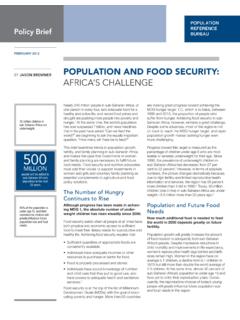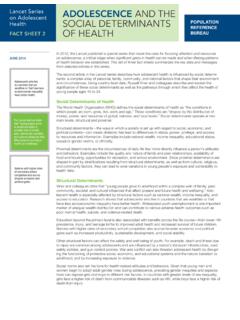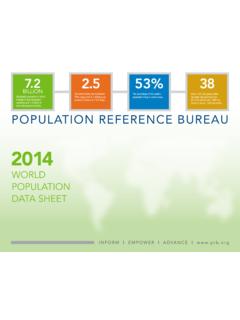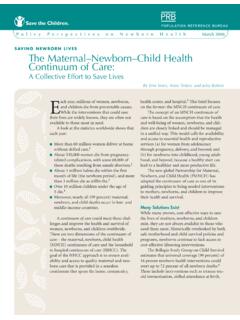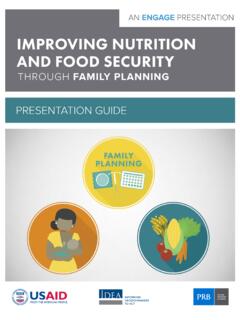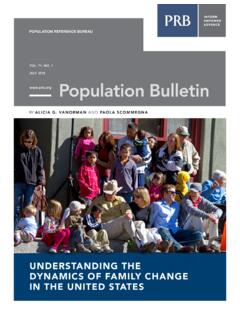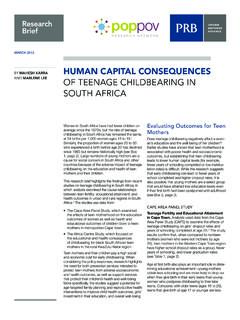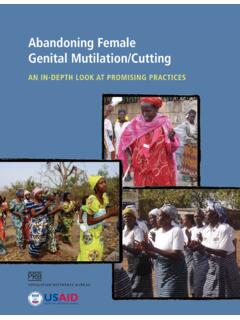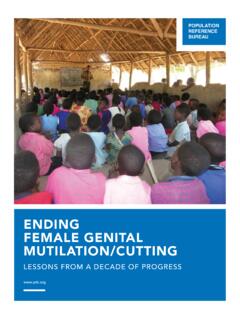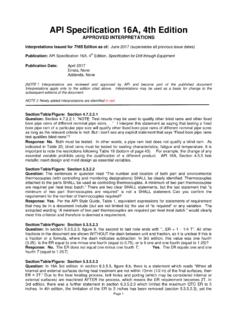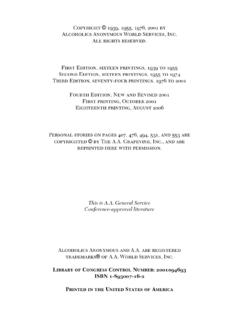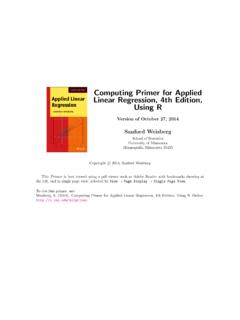Transcription of Population: A Lively Introduction, 4th Edition
1 New EditionOur fascination with population stems from an interest in our own is a fundamental aspect of any population. Demographic forces have a profound impact on : A LivelyIntroduction,4th Editionby Joseph A. McFalls A publication of the Population Reference BureauPopulationVol. 58, No. 4 December 2003 Population Reference Bureau (PRB)Founded in 1929, the Population Reference Bureau is the leader in providing timely andobjective information on and international population trends and their informs policymakers, educators, the media, and concerned citizens working in the public interest around the world through a broad range of activities, including publications,information services, seminars and workshops, and technical support. Our efforts are sup-ported by government contracts, foundation grants, individual and corporate contributions,and the sale of publications.
2 PRB is governed by a Board of Trustees representing diversecommunity and professional P. Bentzen,Chairman of the Board, Partner, Hughes and Bentzen, PLLC, Washington, Gober,Vice Chairwoman of the Board, Professor of Geography, Arizona State University, TempeWilliam P. Butz, President and Chief Executive OfficerPopulation Reference Bureau, Washington, T. Allen,Secretary of the Board, Managing Editor, News & World Report, Washington, F. Hokenson,Treasurer of the Board, Director, Hokenson and Company, Lawrenceville, New JerseyTrusteesPatty Perkins Andringa,Consultant and Facilitator, Bethesda, MarylandSuzanne M. Bianchi,Professor of Sociology and Director of the Population Research Center, University of Maryland, College ParkBert T. Edwards,Executive Director, Office of Historical Trust Accounting, Office of the Secretary, Department of the Interior, Washington, James H.
3 Johnson Jr.,William Rand Kenan Jr. Distinguished Professor and Director, Urban Investment Strategies Center, University of North Carolina, Chapel HillTer r y D. Peigh,Executive Vice President and Director of Corporate Operations, Foote, Cone & Belding, Chicago, Illinois Francis L. Price,Chairman and CEO, Q3 Industries and Interact Performance Systems, Columbus, OhioDouglas Richardson,Executive Director, Association of American Geographers, Washington, B. Schermerhorn,Managing Director of Technology, Goldman, Sachs & Company, New York Barbara Boyle Torrey,Independent Writer and Consultant, Washington, Visaria, Professor, Gujarat Institute of Development Research, Ahmedabad, IndiaMontague Yudelman,Senior Fellow, World Wildlife Fund, Washington, Marcy,Chairwoman Emerita1 Page 3 Page 17 Population: A Lively Introduction, 4th EditionIntroduction.
4 3 Fertility.. 4 Box Intermediate Variables That Affect Fertility .. 5 Box Measures .. 6 Figure Birth Rates by Age of Mother, Selected Age Groups, 1955 2002 .. 8 Figure Patterns of Fertility: Japan, Mali, and the United States, 2001 .. 9 Mortality.. 10 Figure Death Rates by Age for Males, 1900 and 2001 .. 10 Figure Expectancy at Selected Ages for Males and Females,Japan, 2001 .. 11 Table 1. The 15 Major Causes of Death: United States, 2001 .. 13 Migration.. 14 Table 2. Population in 2000 by Residence in 1995 .. 15 Figure Who Moved Last Year, by Age: United States, 2001 .. 16 Population Size and Growth.. 19 Box Demographic Balancing Equation .. 20 Box Do Demographic Data Come From?.. 21 Box and Families .. 22 Population Composition.. 23 Figure Pyramids: Mali, United States, and Italy, 2000.
5 24 Figure 7. Germany s Population by Age and Sex, 1996 .. 27 Figure of the United Arab Emirates, by Age and Sex, 2000 .. 28 Population Distribution.. 30 Figure Distribution of World Population, 1950, 2003, and 2050 .. 31 Population Growth Issues.. 32 Figure Population Growth Through History .. 33 Figure Classic Stages of Demographic Transition.. 34 Page 26 Continued on page 2 BULLETIN A publication of the Population Reference BureauPopulationVol. 58, No. 4 December 20032 About the AuthorJoseph A. McFalls Jr., a demographer and sociologist, is a professor at Villanova received a in demography from the University of Pennsylvania and an MBAfrom the Harvard Business School. His research interests center on population fecundity andthe demography of the black population. He is the author or co-author of numerous arti-cles and books, includingSociology, Disease and Fertility, Psychopathology and Subfe-cundity, andSocial Problems.
6 The author wishes to acknowledge the extensive and expert editorial assistance of MaryKent and contributions made by other PRB staff members. Ann Riley provided valuable com-ments on the earlier Edition . 2003 by the Population Reference BureauConcern About Population.. 36 Conclusion.. 37 References.. 38 Suggested Resources.. 403 Most people think demographyis just math in disguise asort of dry social exposed to the subject, manychange their minds. They come toappreciate the profound impactdemographic forces have on has never been more true thanduring the past half-century, a periodin which the United States and othersocieties have experienced unprece-dented social and demographicchange. Since these demographicforces have not been stilled, they willcontinue to cause social change andto shape social programs for the bal-ance of our lives and also find demography fasci-nating because it deals with so manypersonally relevant topics.
7 Nearly allthe major events of people s lives havedemographic implications: birth,schooling, marriage, choosing anoccupation, childbearing, retirement,and death. Consider the followingquestions: When and where were you born?How many others were born thesame year? What is your probability of gettingmarried or divorced? Do you have children or do youever plan to? How many, and howfar apart? What kind of job will you have?How often will you change jobs?What are your chances of promo-tion? When will you retire? How many times will you move?Will you move around the block oroverseas? How long will you live? What arethe chances of your dying within ayear? Within 10 years? What islikely to kill you?These are all in part demographicquestions. Indeed, if people are notinterested in demographic phenom-ena, they are not interested in , or population stud-ies, is a discipline, an interdisci-pline, and a subdiscipline.
8 It isclearly a discipline because it is afield with its own body of interre-lated concepts, techniques, journals,departments, and professional associ-Population: A LivelyIntroductionby Joseph A. McFalls study of population delves into personally relevanttopics for individuals and societies all over the removed for copyright Demography is also an inter-disciplinary field because it draws itssubject matter and methods frommany disciplines, including sociol-ogy, economics, biology, geography,history, and the health , demography is also consid-ered a subdiscipline within some ofthese same major disciplines. In mostuniversities, demography courses aretaught within the sociology curricu-lum, perhaps because populationphenomena have so long beenlinked to social is defined as thestudy of human populations: theirsize, composition, and distribution, aswell as the causes and consequencesof changes in these are never static.
9 Theygrow or decline through the interplayof three demographic processes:birth, death, and migration. If somegroups within a population grow ordecline faster than others, the compo-sition of the whole is Population Bulletinpresentsthe basic what, why, and how of thestudy of demography. It is not a com-prehensive treatment of the subject,but it does provide an overview ofdemographic processes and the basicmeasures used to assess them. In addi-tion, it traces population trends in theworld and the United States, surveysthe demographic differences amongpopulation groups, and examinesbroad social issues linked to popula-tion first three sections of this Bul-letinprovide the framework for study-ing the dynamics of , mortality, and migration areat the root of all demographicchange. The fourth section revealshow changes in fertility, mortality, andmigration affect a population s sizeand growth rate, and how populationprojections are calculated.
10 The fifthsection delves into the composition ofpopulation according to commonvariables: age, sex, and race or ethnic-ity. The sixth section describes howthe geographic distribution of popu-lation changes, primarily throughmigration. The final sections discussissues and problems associated withpopulation study of population dynamicsmust begin with fertility. Fertilityrefers to the number of births thatoccur to an individual or in a popula-tion. In 2003, fertility rates of nationalpopulations ranged from an averageof children per woman in the for-mer Soviet republics of Georgia andUkraine to children per woman inthe West African country of average for the United States , and for the world, In 2003,more than 4 million babies were bornin the United States and about 27 mil-lion in India. Worldwide, 136 millionhuman beings were born, or 258babies per must be distinguished fromits sister term, fecundity, which refersto the physiological ability of individu-als or couples to have children.
